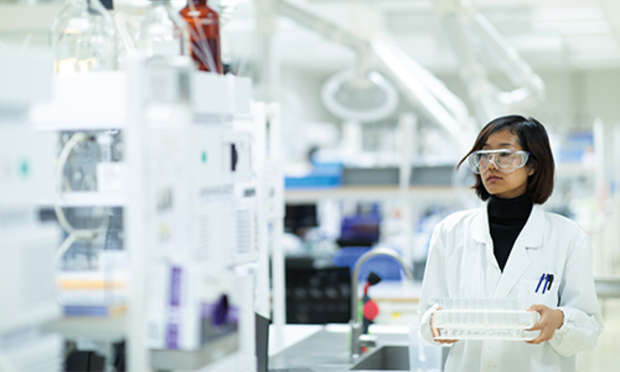What science can do
Annual Report and Form 20-F
Information 2019
Strategic overview
In 2018, we achieved a significant milestone by returning to Product Sales growth. In 2019, we refreshed our strategy to focus on what comes next, and where we want our business to be in 2025. Our strategy reflects ideas which we crowdsourced from our employees and is underpinned by the initiatives outlined below which are intended to accelerate delivery of our strategy.
Understanding disease better
Transforming the discovery and development of innovative new medicines.
Redefining clinical trials
Making clinical trials better and easier for patients.
Improving patient access
Exploring new value-based payment models.
Improving outcomes for patients
Establishing Health Innovation Hubs to deliver patient-focused disease management solutions.
Being a great place to work
Attracting and retaining the best people.
Ambition Zero Carbon
Our strategy to eliminate emissions by 2025 and be carbon negative by 2030.
In the first full year of our return to Product Sales growth, we made good progress in line with our strategy. We anticipate 2020 to be another year of progress.
Leif Johansson, Chairman
AstraZeneca’s first full year of returning to Product Sales growth was made possible by our ability to deliver our science to patients. We are now maximising and exploring the full potential of our leading medicines, rapidly advancing the next wave of science and positioning your Company for continued success.
Pascal Soriot, Chief Executive Officer
Financial Highlights
2019 generated accelerating Product Sales growth from outstanding New Medicine uptake, driving an increase to Core Operating profit.
Revenue and Cash
Total Revenue*
Up 10% at actual rate of exchange to $24,384 million (up 13% at CER), comprising Product Sales of $23,565 million (up 12%; 15% at CER) and Collaboration Revenue of $819 million (down 21%; 20% at CER)
$24.4bn
Net cash flow from operating activities
Up 13% at actual rate of exchange to $2,969 million
$3.0bn
// Denotes a scale break. All bar chart scales start from zero. We use a scale break where charts of a different magnitude, but the same unit of measurement, are presented alongside each other.
*Total Revenue consists of Product Sales and Collaboration Revenue.
Operating profit
Reported operating profit
Down 14% at actual rate of exchange to $2,924 million (down 16% at CER)
$2.9bn
Core operating profit
Up 13% at actual rate of exchange to $6,436 million (up 13% at CER)
$6.4bn
EPS
Reported EPS
Down 40% at actual rate of exchange to $1.03 (down 44% at CER)
$1.03
Core EPS
Up 1% at actual rate of exchange to $3.50 (0% at CER)
$3.50
At a Glance
We are a global, science-led, patient-focused, pharmaceutical company. We have transformed our pipeline and returned to growth. As a result of continued pipeline delivery and commercial execution, we are now entering a new stage in our journey.
Product Sales
Total Product Sales
$23,565m
2018: $21,049m
2017: $20,152m
By therapeutic area
By geography
Employees
70,600
45.4%
91
>3,100
Distributions to shareholders
Dividends
$3,592m
2018: $3,484m
2017: $3,519m
Proceeds from issue of shares1
$(3,525)m
2018: $(34)m
2017: $(43)m
Total
$67m
2018: $3,450m
2017: $3,476m
1. In April 2019, the Company completed a placing of 44,386,214 new Ordinary Shares of $0.25 each in the Company.
Therapy Area Highlights
Oncology
$8,667m
Product Sales (2018: $6,028m; 2017: $4,024m)
Sales growth of 44% (47% at CER), including:
- Tagrisso sales of $3,189 million, representing growth of 71% (74% at CER)
- Imfinzi sales of $1,469 million, representing growth of 132% (133% at CER)
- Lynparza sales of $1,198 million, representing growth of 85% (89% at CER)
- The performance of legacy medicines included a decline in Faslodex sales of 13% (11% at CER) to $892 million, reflecting the launch of multiple generic medicines
Cardiovascular, Renal & Metabolism
$6,906m
Product Sales (2018: $6,710m; 2017: $7,266m)
Sales growth of 3% (6% at CER), including:
- Brilinta sales of $1,581 million, representing growth of 20% (23% at CER), due to continued patient uptake for acute coronary syndromes and post-myocardial infarction
- Farxiga sales of $1,543 million, with growth of 11% (14% at CER), reflecting pricing pressure in the US and a sales increase of 40% in Emerging Markets (48% at CER) to $471 million
- Crestor sales of $1,278 million, down 11% (8% at CER), reflecting generic competition and the effect of volume-based procurement in China
Respiratory
$5,391m
Product Sales (2018: $4,911m; 2017: $4,706m)
Sales growth of 10% in the year (13% at CER), including:
- Symbicort sales of $2,495 million, down 3% (stable CER), as competitive price pressures in the US continued
- Pulmicort sales of $1,466 million, representing growth of 14% (18% at CER) with Emerging Market sales up 20% (24% at CER) representing 81% of global sales
- Fasenra sales of $704 million, up by 137% (139% at CER), with strong sales growth in the US, Europe and Japan
Other Disease Areas
$2,601m
Product Sales (2018: $3,400m; 2017: $4,156m)
Product Sales declined by 24% (21% at CER) and represented 11% of total Product Sales, down from 16% in 2018. This included Nexium sales down by 13% (11% at CER) to $1,483 million
Sustainability
At AstraZeneca, health is our business and our contribution to society. How we operate supports sustainable ecosystems for healthcare that benefit people and our planet through science-based innovation.
Our aspiration is for the future to be healthy and that we are an active participant for a healthy society, planet and business. Our pioneering medicines touch the lives of millions of people so it is a business imperative that we are partners and activists for solutions to global health. At the heart of our sustainability approach is access to healthcare and its connection to environmental protection, and ethics and transparency.


